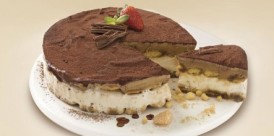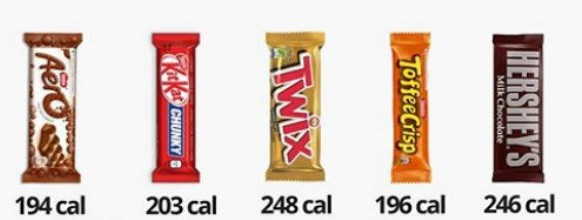Todas, alguna vez, hemos contado cuántas calorías tendrá ese rico sánguche que queremos comernos o cuánto acumulará en nuestro cuerpo esa barra de chocolate con la que te premias cada fin de semana.
Sin embargo, no todo lo que pensamos que sumará una gran cifra es tal , ya que muchas veces algunas de las cosas que consideramos saludables puede que nos estén adicionando la misma cantidad de calorías que algo catalogado como normal.
Imagine this. You’re with a friend who’s goal is also to lose fat and take control of their body composition. You’re both in a convenience store. Your friend decides to opt for 100g of this ‘healthy superfood mix’, whilst you see a kit kat chunky and cannot resist. In fact you like them so much that you’ll take two… – – There you both are, eating your snacks. Your friend is smug, you are beginning to feel guilty about your choice (as you nibble the chocolate around the edges)…. All the while, both oblivious to the fact that TWO kit kat chunky’s (406 calories) is a BETTER one-off choice for your goal than 100g of a so called superfood mix (480 calories). FYI – one KK chunky is 203 calories… – – I have said this many times and I’ll say it once more. Body composition is entirely determined by energy balance (calories in vs calories out). If you create a calorie deficit you will reduce fat, if you create a calorie surplus, you will gain fat. It is literally this simple and it always will be. – – Now then. The fruit and nut mix contains more nutrients than a kit kat chunky. But nutrients do not define body composition, calories do. – – If fat loss is the goal, you MUST understand and be aware of the calories you consume, whether it’s from some miracle berry, a mound of broccoli or a tub of Ben and Jerry’s. – – If you humanise the concept of body composition; it doesn’t care about nutrients, it only cares about calories. Of course, in order to optimise health, you want to find the sweet spot between consuming adequate nutrients for health & function, whilst finding the right energy (calorie) balance for health and composition. – – The fruit & nut mix isn’t good as much as the kit kat chunky isn’t bad. Blindly assuming one food will help with fat loss because it contains more nutrients is a naive and redundant thought process. You need to see food as food, enjoy it, but be aware exactly what consumption means for your goal . – – #thefitnesschef #kitkat #snacktime #snack #calories #caloriecounting #fatlosstips #superfood #fatlosscoach #losefat #losebellyfat #fatlossjourney #healthysnack #nutrients #flexibledieting #balanceddiet #dieting #diet
Una publicación compartida de Graeme Tomlinson (@thefitnesschef_) el 2 Jul, 2018 a las 11:13 PDT
Por eso, todo un descubrimiento ha sido la cuenta de Instagram The Fitness Chef donde, a través de didácticas infografías y fotos, muestran cuánto suman a nuestra ingesta calórica algunos alimentos y comparan también varias propuestas diet con las que no lo son.
“Me frustraba la información errónea en masa sobre la nutrición básica en las redes sociales”, señaló al sitio Metro Graeme Tomlinson, el responsable tras la cada vez más popular cuenta.
Y agregó que “comencé mi página hace unos años publicando recetas, pero se ha disparado recientemente porque estoy educando a las personas con información simple que es fácil de entender”.
Acá te dejamos algunos de sus posteos:
Tag a McDonald’s lover, hit save and keep both you and your friends informed on the calorie values of this bunch of the franchise’s items. – – Whilst most McDonald’s item’s ingredients lack the quality and nutrient density of a whole foods, I think most of us already know this. But the pertinent thing here is that people enjoy Macdonald’s. And people will consume their items now and for years to come. This is evident by the ferocity in which Macdonald’s has dominated the fast food market for decades. – – Therefore, instead of lambasting somebody (or yourself) for choosing a Big Mac over a kale salad, why not become more aware of what consumption of their food means in simple terms. Perhaps this awareness will consequentially mean that a higher quality food is selected instead in order to fit your plan better, or simply that you are more aware that you can actually fit these items into your current, flexible diet. – – As you can see, I’ve listed these items in singularity, but when combined into a meal (and with a sugary drink), the calorie value can rise fairly high for the volume of food consumed. – – That said, what’s your go to? If you have one at all…? If your despise Macdonald’s, feel free to comment “McDonald’s can get f*cked” . – – #thefitnesschef #mcdonalds #bigmac #fatloss #fastfood #calories #caloriedeficit #losebellyfat #mcflurry #mcmuffin #nutritioncoach #fatlosshelp #fatlosscoach #burgerlover #mcdonaldsbreakfast #losefat #fatlosstips #eatsmart #nutrients
Una publicación compartida de Graeme Tomlinson (@thefitnesschef_) el 2 Ago, 2018 a las 10:09 PDT
You want to lose fat. You ask for advice. “Mr Nutritionist, can you please suggest a low calorie snack?” “Fruit of course” – says every voice of health conscious reason in the land… And that’s it. You toddle off in determination. – – You go to the shop. It’s fruit this time. But you want convenience. You see the dried fruit. You know it tastes sweet. You look at the ingredients. 100% fruit. You’re in. In your head, dried fruits are; easy to store, portable, taste nice and have a longer used by date. You begin horsing dried fruit at your desk every day like Oliver Twist on his first helping of grool. And you feel f*cking chuffed with yourself. – – The general advice isn’t wrong in the sense that [in isolation] fruit contains nutrients, fibre and hydration which benefit our overall health more so than a processed snack. The problem lies though, in the depiction of what state the fruit is in. For example, both sets of fruit in my graphic contain the same food and equal weight. Yet one side is drastically higher in calories and sugar than the other side. How? – – Well, it’s a very simple answer. If we take banana as an example; it gets 70% of its weight from water. Whereas dried bananas lose around 95% of water content, making them a far more concentrated calorie source. The same logic applies for any dried fruit. Essentially, per 100g, you’re eating the calorie and sugar worth of what would be a LOT more fresh fruit. That is literally how simple it is. – – Snacking on fruit is beneficial. But you still have to be smart about it. If fat loss or reducing sugar intake is your aim, you can consume a greater volume of food per calories when the fruit is fresh. Consuming more food & less calories is a logical idea. – – On evidence of this, it’s also a good idea to become more aware of what consumption of any food means in relation to your overall energy intake, regardless of its nutritional prowess . – – #thefitnesschef #driedfruit #highsugar #freshfruit #caloriedeficit #calories #sugar #fatlosstips #fatlosshelp #nutritiontips #nutritioncoach #dieting #losebellyfat #snacktime #lowcaloriesnack #fatlossgoals #nutritionfacts
Una publicación compartida de Graeme Tomlinson (@thefitnesschef_) el 16 Ago, 2018 a las 11:18 PDT
Tag a Starbucks lover and keep them informed on the basic calorie properties of their favourite drinks ☕️. – – Whilst the only real coffee on this graphic is the black (Americano), the top tier can probably still be classed as authentic coffee. The bottom tier? Given most of the ingredients resemble an ice cream sundae, they are not probably coffee. Therefore if you regularly go out for a ‘coffee’, but consume a Frappuccino, you’re going out for dessert more so than going out for coffee. – – Regardless of terminology, it’s useful it be aware of liquid calories consumed. For example, based on grande & 2% milk servings; 3 cinnamon roll Frappuccino’s per week will equate to 1470 calories. 7-10 vanilla latte’s per week equates to 1750-2500 calories. 25 Americano’s per week equates to 0 calories… – – Coffee is loved universally (and rightfully so), but if fat loss is the goal and little progress is being made, consuming a days worth of calories each week from ‘coffeeish drink’ may not be the best idea. However, any drink in this graphic can fit into any diet with as much regularity as you please, as long as it supports your overall energy balance target. – – Coffee does not contain calories. Therefore a drink which classes itself as coffee, yet contains other ingredients which accumulate the calories of that drink into the hundreds, is probably not real coffee. Even if it is delicious . – – That said…. Which one is your favourite? – – #thefitnesschef #coffee #coffeelover #coffeetime #frappuccino #icedlatte #fatlosshelp #caloriedeficit #caloriecounting #calories #fatlosstips #fatlosscoach #nutritioncoach #nutritionfacts #losefat #icedcoffee #cappuccino #balanceddiet #coffeeaddict
Una publicación compartida de Graeme Tomlinson (@thefitnesschef_) el 25 Jul, 2018 a las 9:09 PDT
Nights out are there to be enjoyed. Chances are that they aren’t going to be enjoyed fully if you track every calorie you consume. But there is room for some sort of awareness of the energy you are consuming. This same awareness can be the difference between a great night out where you consume a huge access and an equally great night out where you limit the damage. – – For example; on the left there is multiple consumption of double vodka coke.. on the right – single vodka diet cokes. A significant calorie saving here. – – In addition, on the left there is copious amounts of drinks, some may say ridiculous. On the right, a reasonable amount, but not stupid. More calorie savings. – – Finally, on the left, we have the ‘consequential of being plastered’ decision to eat a pizza. On the right there is no pizza. 2000 calories saved. – – This example is indicative of the whole “I eat really healthy during the week and let my hair down at weekend”mentality. Let’s say Ashley (unisex) has a 10% calorie deficit for fat loss set at 1800 calories per day (12600 per week). Sun-Fri he/she nails it and hits 1800 daily to a tee, so much so that he/she feels he/she deserves to go out and ‘unwind’. But he/she consumes 4100 calories on top of his/her 1800, totaling 5900 calories on Saturdays… Every week. That’s a new daily average of 2300 calories per day, not 1800. That’s 3 days worth of calories in 1. If done 4 times a month – an extra 8 days of calories. – – Let’s face it, it’s fun to go on nights out. They should be enjoyed as part of a healthy lifestyle. But when the calorie excess prevents you from achieving your goal, it’s probably a good idea to limit their frequency, or adopt a few tips from the right hand side of this graphic. Both sides of this graphic achieve they same outcome – fun. But they represent entirely different meanings in terms of body composition. – – P.s. Going home with someone is optional . – – #thefitnesschef #nightout #caloriedeficit #calories #nutritioncoach #caloriecounting #fatloss #alcohol #prosecco #losefat #fatlosscoach #eatsmart #fatlosstips #fatlossjourney #flexibledieting #drunk #nutritioncoach #nightoutonthetown #portioncontrol
Una publicación compartida de Graeme Tomlinson (@thefitnesschef_) el 1 Jul, 2018 a las 10:53 PDT













COMENTAR